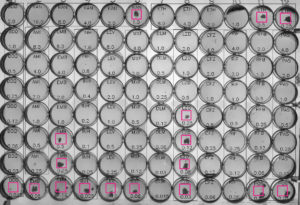Automated detection of bacterial growth from a photograph of a 96 well plate

The development of multi-drug resistant (MDR) bacteria is currently one of the most pressing issues in modern human and animal health. This has led to the development of rapid microbiological detection techniques to improve antibiotic susceptibility testing and optimise patient care.
Oxford scientists have developed software to read digital images of microbial growth under different antibiotic conditions. Microbiologists will be able to perform fast and reliable measurements to determine which antibiotic would be most effective for each individual case.
Controlling antibiotic usage
Antibiotic resistance is one of the most pressing public health problems around the world. Resistance arises when bacteria change and continue to multiply in the presence of therapeutic levels of an antibiotic. Although resistance is a natural process, it develops more rapidly through the misuse and overuse of antibiotics. Therefore great care needs to be taken in selecting the correct antibiotics for treating each infection.
High throughput screening
Microtitre plates are standard equipment in both clinical and research laboratories. They allow microbiologists to carry out large numbers of drug susceptibility testing on small amounts of material in a high throughput manner, thus giving clinicians rapid feedback on the most appropriate treatment for a given infection. Many laboratories use automated systems for filling and incubating the plates that can contain thousands of wells. However, analysis of the results of such studies is generally done by eye and is prone to mistakes. A more reliable way to measure the amount of bacterial growth would be of great benefit.
Image processing of 96-well microtitre plate
Researchers at the University of Oxford have developed a software solution capable of interpreting the results of antibacterial assays carried out in 96-well plates. The technology makes use of existing camera infrastructure, but can significantly decrease the amount of human time required. Whilst this technology has been developed primarily for antibiotic susceptibility testing using M. tuberculosis, it could also be used for Bacillus subtilis, Staphylococcus aureus and other circular forming bacterial colonies. This technology has been validated so far on more than 24,000 independent measurements of minimum inhibitory concentration (MIC).
The main benefits of the technology are:
- Rapid and accurate analysis of a photograph of 96-well plate assays
- Reduction of subjective nature of tests
- Low-cost implementation
- Makes use of existing plate reader and image capture infrastructure
- Applicable to a research or clinical setting
about this technology

